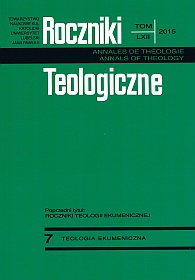Biblical Motif of Tearing of a Vesture as a Symbol of Division of a Community in the Light of 1 Kings 11:29–39 and John 19:23–24
Abstrakt
Biblijny motyw rozdarcia szaty jako symbol podziału wspólnoty w świetle 1 Krl 11,29-39 i J 19,23-24
Prezentowany artykuł analizuje dwa teksty, w których pojawia się motyw rozdarcia szaty użyty jako symbol. W tekście 1 Krl 11,29-39 podzielony płaszcz Jeroboama staje się symbolem rozbitego królestwa Dawidowego. Powstaną z niego dwa królestwa: Izrael i Juda. Według teologicznej interpretacji przyczyną tego podziału jest grzech króla. Tekst J 19,23-24 opisuje scenę podziału szat Jezusa. Niepodzielona tunika Jezusa symbolizuje jedność Kościoła. W przypadku sceny ukazanej w Czwartej Ewangelii mamy do czynienia z jej podwójnym przesłaniem. Najpierw wskazuje ona na różnorodność, jaka istnieje w Kościele, który sięga po krańce ziemi. Następnie podkreśla fakt, że wspólnota Kościoła, mimo że zróżnicowana, jest jedną, niepodzielną wspólnotą, a to dlatego, że pochodzi ona „z góry”, nie jest uczyniona ręką ludzką.
Bibliografia
Brown, Raymond E. The Death of Messiah. From Gethsemane to the Grave. Vol. 2. (The Anchor Bible Reference Library). New York–London–Toronto: Doubleday 1998.
Cogan, Mordechai. 1 Kings. A New Translation with Introduction and Commentary. (Anchor Bible 10). New York: Yale University Press, 2001.
Cohn, Robert L. “Literary Technique in the Jeroboam Narrative.” Zeitschrift für die alttestamentliche Wissenschaft 98 (1985), No. 1: 23–35.
Culpepper, Alan. “The Theology of the Johannine passion narrative: John 19:16b-30.” Neotestamentica 31 (1997), No. 1: 21–37.
de la Potterie, Ignace: Męka Jezusa Chrystusa. Kraków: WAM, 2006.
DeVries Simon J. 1 Kings. (WBC 12). Nashville: Thomas Nelson Publishers, 2003.
Ewald, Heinrich. The History of Israel. Vol. 3: The Rise and Splendor of the Hebrew Monarchy. London: Longman, Greens and Co., 21878.
Leuchter, Mark. “Jeroboam the Ephratite.” Journal of Biblical Literature 125 (2006): 51–72.
Linville, James Richard. Israel in the Book of Kings. (Journal for the Study of the Old Testament Supplement Series 272). Sheffield: Sheffield Academic Press, 1998.
Min Chun, S. “Whose Cloak did Ahijah Seize and Tear? A Note on 1 Kgs 11,29-30.” Vetus Testamentum 56 (2006), 268–74.
Schnackenburg, Rudolf. Das Johannesevangelium 13-21. (Herders Theologischer Kommentar zum Neuen Testament IV/3; Sonderausgabe). Freiburg–Basel–Wien: Herder, 2001.
St. Augustine. Tractates on the Gospel of John 112-124. (The Fathers of the Church. A New Translation 78). Translated and edited by J.W. Rettig. Washington: Catholic University of America Press, 1995.
St. Cyprian. Treatises. (The Fathers of the Church. A New Translation 36). Translated and edited by R.J. Deferrari. New York: Catholic University of America Press, 1958.
Siemieniec, Tomasz. “Division (schisma) as a Reaction to Self-Manifestation of Jesus’ Person in the Light of John 7,43.” Studia Oecumenica 13 (2013): 139–47.
Tułodziecki, Tomasz. Jeroboam – reformator religii Izraela. (Rozprawy i Studia Biblijne 14). Warszawa: Vocatio, 2004.
Weippert, Helga. “Die Ätiologie des Nordreiches und seines Königshauses (I Reg 11,29-40).” Zeitschrift für die alttestamentliche Wissenschaft 95 (1983), No. 3: 344–75.
Copyright (c) 2015 Roczniki Teologiczne

Utwór dostępny jest na licencji Creative Commons Uznanie autorstwa – Użycie niekomercyjne – Bez utworów zależnych 4.0 Międzynarodowe.





